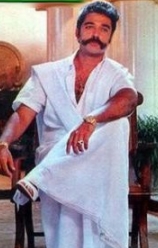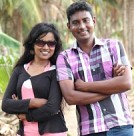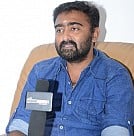PHOTOS & STILLS - GALLERY

PUC TO AJITH: A BRIEF HISTORY OF MEESAI
As I gradually entered my teens and my testosterone levels spiked up spurring changes in my face, one crucial indication of my masculinity will remain forbidden for me to alter – my moustache. I had received strict instructions from my father forbidding me to either trim or shave my just-sprouting moustache. There was no question of demurring, the orders were made. I was growing and moustache is a sign of masculinity for boys, I was told.
This obligation to exhibit moustache-flaunting masculinity is not reserved to my household. The collective consciousness of Tamil movies and the rulebook of filmmaking predefined moustache as a must-have for a movie’s hero. Just as the heroines are supposed to look pleasantly plump unlike their size-queen Bollywood counterparts (a view that is fast changing), the men ought to sport the supposed symbol of manhood – a moustache. Songs eulogizing the virtues of a man who possess moustache and the moustache itself are dime a dozen in Tamil.
While the early superstars of Tamil MK Thyagaraja Bhagavathar and PU Chinnappa surprisingly did not sport a moustache, the reigning superstars of the 50s (through the 70s) MGR and Sivaji Ganesan insisted on one. There are exceptions in the case, prominent being Sivaji’s Thillana Moganambal. The subsequent decades followed the footsteps and while all the big stars of Tamil have more or less stuck to the prevalent tradition, Kamal experimented with his looks and he was always considered to be someone on a different league. Rajini’s Thillumullu remained a stark retreat from his moustache-wielding roles.
In 1990, when actor Prashanth who was barely 17 back then, debuted in the Tamil movie ‘Vaigasi Poranthachu’, Tamil tabloids wrote about how he had to thicken his meager growth of facial hair on his upper lips with black makeup. On the other hand, in the consecutive year when he appeared in the Malayalam movie Perumthachan, he appeared without any cosmetic help to enhance his moustache. His rebel of a Kannan Vishwakarman did not have pronounced facial hair. Malayalam cinema is forgiving of its actors for their moustache-less actuality or lets them get away with their preference.
In a particularly poignant scene in Thevar Magan (later remade as Viraasat in Hindi), Kamal’s character Sakthivelu takes over his father Periya Thevar’s (played by Sivaji Ganesan) role as the village headman after his death. The physical transformation of Sakthivelu to resemble Periya Thevar is complete with his father’s Kada Meesai while the villagers comment on how much he has taken after his father. A moustache is also often considered as a sign of respect and its cosmetic value is elevated into a state of reverence - at least in the imagination of directors.
So what makes a moustache’s appeal enduring? A survey conducted by The Madurai Messenger online magazine in 2012 to render some perspective to the phenomenon reflects the collective thinking – that a moustache makes a man, well, manly. The sampling of the survey was random and the respondents list included representation from various sections of the society – auto drivers, businessmen, daily wage workers and students. The survey concluded that ‘Surely every man in Madurai has a beautiful moustache!’1
Towards the late nineties tough, somewhere along the way actors like Madhavan and Abbas brought about a slight change in the outlook of perceptions about looks in Tamil films. Although Abbas brought the clean-shaven hero to Tamil with his 1996, Kadhal Desam, Madhavan’s Alaipayuthey brought home the idea that it is cool to be moustache-less. By then, however, aforementioned Prashanth has dared to shed his whiskers for the multi million budgeted Jeans, opposite Aishwarya Rai.
Prashanth’s looks raises a few questions for many reasons: did director Shankar want Prashanth’s looks to be clean-shaven because he is paired with Aishwarya Rai? Did he want it so because the film’s lead man is an NRI or is it a way to attract urban audiences? After all, multiplexes were slowly catching up and urban audiences were to be lured. For Prashanth though, Jeans worked as a way to shed the stereotype associated with moustaches and enabled him to act in subsequent movies without one.
The subsequent decades (the 2000s) were more or less eventless with the exception of Ajith often opting for stubble and making it seem okay. That scruffy stubble popularized by Ajith became quite a rage and provided an in-between state somewhere in the middle of clean-shaven cultural reformism and a conventional moustache. Ajith’s contemporaries remained non-experimental with facial hair (with an exception of Suriya).
Shankar would again become the harbinger of change with his coming of age romance drama Boys, released in 2003. The movie’s lead Siddharth and the film’s second and third leads went without a moustache (and it was probably a decision taken keeping in mind with the fact that all the boys in the movie are in their adolescent).
There is an interesting transition underway in Tamil movies – new generation actors seem keen to get comfortable in their character’s skin and hence pay no attention to existing stereotypes. Either it comes from their strong willed refusal to be pigeonholed or just to avoid being labeled an old-timer. Cultural mandates are being elbowed out. As small movies make it big and keep the turnstiles busy, the longstanding perceptions about movie making and what the audience look for in a movie is undergoing a vast change. With that, possibly the notion that moustache makes a man.
It is, however, still a strict taboo for a lead man in a Tamil movie - if he is a cop - to go without a moustache. For a moustache on a policeman is an indication of power and instills fear and intimidation. Suriya’s Kakka Kakka and Singham are examples. While John Abraham, in the Hindi remake of Kakka Kakka, Force, opted for a scruffy look, Ajay Devgn thought a crisp moustache will go well with his newly acquired six-pack in the Singham remake.
Even as the demography of Tamil youth undergo a cultural shift (insofar men wearing shorts was uncommon even in a city like Chennai before but you get to see girls freely dressed so now) with exposure from external influences signaling the arrival of a new generation that favors movies for their stories over the significance of their songs and lead actors, moustache is an unprecedented victim of the cultural reformation.
The jury is still out on whether or not moustache acquires the same cultural significance it commanded a few years ago. As for my moustache, I begrudgingly lived with one as long as I was under my parents’ supervision only to opt for a spotless upper lip as soon as I moved out of home. Cultural connotations be doomed.
Behindwoods is not responsible for the views of columnists.
FACEBOOK COMMENTS
OTHER LATEST COLUMNS
PRATHAP'S OTHER COLUMNS
- Shweta & Anjali - the case of hope and despair!
- Best of Iranian Films - Must Watch
- Hits & misses of the last seven months
- Blue Valentine - Does love come with an expiry date?
- Five lessons from Soodhu Kavvum
- Roger Ebert: the pundit passes away!
- The new Vijay on the block!
- Celebrity weddings that never happened in 2012!
- Thilakan - A tribute?
- The comeback queen!
- Five surprises of 2012
- The gangster Indian movie this year at Cannes!
- 5 Blockbuster Film Ideas!
- Look what Kolaveri did to Dhanush!
- Forgotten Gems of 2011
- The south show!
- Guess Suriya / Ajith?s Valentine?s Day gift?
- What?s cooking in captain?s kitchen for elections?
- Five things for 2011!
- Is Tamil cinema in safe hands?
- Blatant vulgarity or conservative ?
- Quarter Cutting: What Shiva did that Vijay and Surya didn?t?
- The curious case of moustaches?
- Whose tweet is it anyway?
- The legend of Silk Smitha
- Songs ? What good are they anyways?
- The dilemma of being small!
- Going Bollywood...!
- Politics and cinema: the twin brothers!
- Freedom of expression: The changing dimensions!
- Oh Vikram, where art thou?
- Tamil cinema: Sighting the elephant in the room!
- The hide and seek with censors!
- The look-alikes of Kollywood!
- Dummies guide to surviving bad movies
- 2009 ? The winners and losers!
- Thin is in!
- Living on the edge ? the celebrity life!
- The death of punch dialogues!
- Downloading movies, nothing legal about it!
- Smart and savvy - the daddy?s girls of Kollywood
- The celebrity social network!
- Cannes 2009 ? of designer gowns and serious movies!
- The war against Multiplexes!
- The fire called Nandita!
- The Indian Oscars!
- The Nayan conundrum
- Oscar is not far, after all!
- 7 good movies you probably missed @ the theatres
- Dostana Tamil Remake, anyone?
- The Thala Deepavali that wasn?t!
- Is Taare Zameen Par Oscar-worthy?
- The fashion offenders of Kollywood
- Celeb Craze ? So how fanatic are we?
- Can Ajith & Vijay revive the TRPs?
- The Chennai bred six-pack!
- 'Unblocking the creativity block'
- Pra test3
- Pra test2
- Pra test1
- New test
RELATED LINKS
- 4. Suriya | Top 20 Actors in Tamil - Slideshow
- Do you know who Rajinikanth is?
- Suriya - Trisha | A new start for Selvaraghavan and Captain Vijayakanth - TOP 10 NEWS - Slideshow
- Why is our Superstar an inimitable phenomenon?
- Vaazhvil Meendai Vaiyam Vendraai, Ellai Unakkillai Thalaivaa | 12 lines that define Rajini - Slideshow
- Engae Pogudho Vaanam, Ange pogirom Naamum | 12 lines that define Rajini - Slideshow
- Maamalaigal Thaduthaal, Thaavum Maegam Aavom | 12 lines that define Rajini - Slideshow
- Aagaayam Thaduthaal, Paayum Paravai Aavom | 12 lines that define Rajini - Slideshow
- Vaazhthiya Manangalukku En Vaazhkayai Vazhangi Vittaen | 12 lines that define Rajini - Slideshow
- Ungalin Vaazthukkaalal Uyir Kondu Ezhundu Vittaen | 12 lines that define Rajini - Slideshow
- Ilaya Singame, Ezhundhu Poradu, Poradu | 12 lines that define Rajini - Slideshow
- Endhan Villum, Solliya Sollum, Endha Naalum Poithathillai | 12 lines that define Rajini - Slideshow
- Vettrigal Enbadhallam, Vaal Kandu Pirappadhadaa | 12 lines that define Rajini - Slideshow
- LATCHIYAM ENBADHELLAM, VALI KANDU PIRAPPADHADAA | 12 lines that define Rajini - Slideshow
- Vettri Unnai Vandhu Kenjum Kenjum Kenjum | 12 lines that define Rajini - Slideshow











